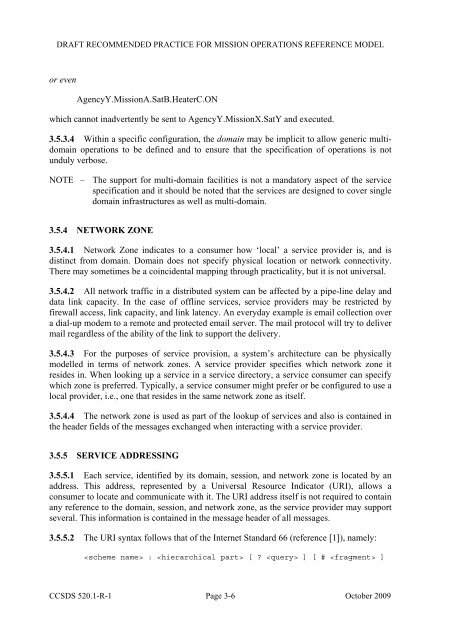Mission Operations Reference Model. Draft ... - CCSDS
Mission Operations Reference Model. Draft ... - CCSDS
Mission Operations Reference Model. Draft ... - CCSDS
You also want an ePaper? Increase the reach of your titles
YUMPU automatically turns print PDFs into web optimized ePapers that Google loves.
DRAFT RECOMMENDED PRACTICE FOR MISSION OPERATIONS REFERENCE MODELor evenAgencyY.<strong>Mission</strong>A.SatB.HeaterC.ONwhich cannot inadvertently be sent to AgencyY.<strong>Mission</strong>X.SatY and executed.3.5.3.4 Within a specific configuration, the domain may be implicit to allow generic multidomainoperations to be defined and to ensure that the specification of operations is notunduly verbose.NOTE – The support for multi-domain facilities is not a mandatory aspect of the servicespecification and it should be noted that the services are designed to cover singledomain infrastructures as well as multi-domain.3.5.4 NETWORK ZONE3.5.4.1 Network Zone indicates to a consumer how ‘local’ a service provider is, and isdistinct from domain. Domain does not specify physical location or network connectivity.There may sometimes be a coincidental mapping through practicality, but it is not universal.3.5.4.2 All network traffic in a distributed system can be affected by a pipe-line delay anddata link capacity. In the case of offline services, service providers may be restricted byfirewall access, link capacity, and link latency. An everyday example is email collection overa dial-up modem to a remote and protected email server. The mail protocol will try to delivermail regardless of the ability of the link to support the delivery.3.5.4.3 For the purposes of service provision, a system’s architecture can be physicallymodelled in terms of network zones. A service provider specifies which network zone itresides in. When looking up a service in a service directory, a service consumer can specifywhich zone is preferred. Typically, a service consumer might prefer or be configured to use alocal provider, i.e., one that resides in the same network zone as itself.3.5.4.4 The network zone is used as part of the lookup of services and also is contained inthe header fields of the messages exchanged when interacting with a service provider.3.5.5 SERVICE ADDRESSING3.5.5.1 Each service, identified by its domain, session, and network zone is located by anaddress. This address, represented by a Universal Resource Indicator (URI), allows aconsumer to locate and communicate with it. The URI address itself is not required to containany reference to the domain, session, and network zone, as the service provider may supportseveral. This information is contained in the message header of all messages.3.5.5.2 The URI syntax follows that of the Internet Standard 66 (reference [1]), namely: : [ ? ] [ # ]<strong>CCSDS</strong> 520.1-R-1 Page 3-6 October 2009
















